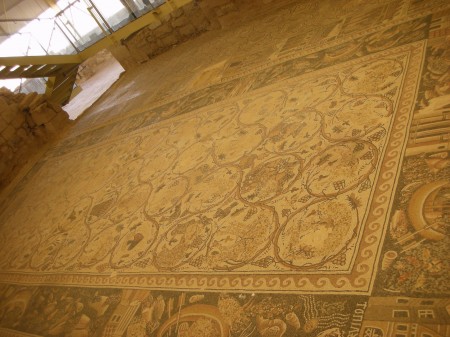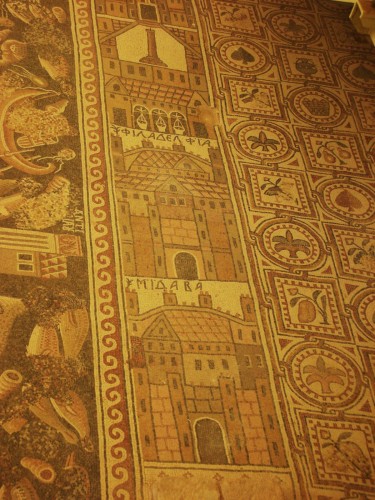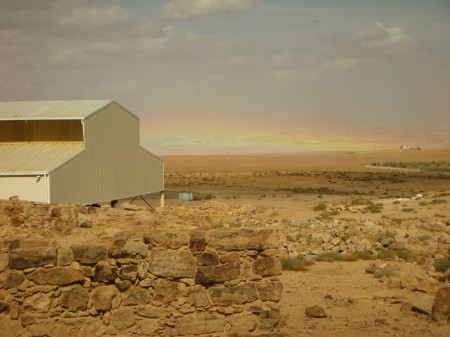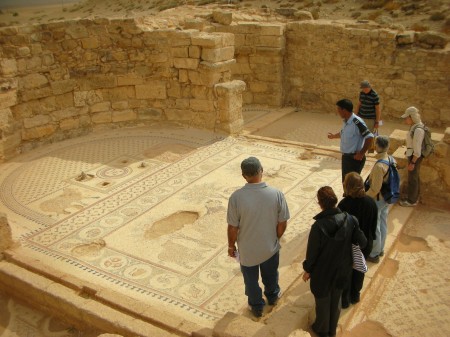Besides Amman International Christian, the church I go to with my friends from Whitman, I have a second church near first circle that I try to go to every other weekend, the English Speaking Congregation of the Anglican Church – a little more of a mouthful. I love the ESCAC because of the trips they’ll take, and yesterday I joined them for another one.
Um ar-Rasas (أم الرصاص) is just south of Madaba, and was about an hour to reach from Amman. Two school buses of congregation members were loaded up and headed south on the sunny and surprisingly chilly morning, chilly enough that several among us were wearing windbreakers. It would appear that autumn has finally struck Jordan. On the highway south, we came across the largest dust storms I’d ever seen here in Jordan, in which the entire desert was blanketed in blowing white dust and sand, swirling around the bus and making our normally-imperturbable Arab driver quietly roll up his window (thank goodness).
After we arrived at the clean, modern guest facilities of the ancient Greek/Roman ruins, a Bedouin police officer greeted us and we were quickly escorted out into the fallen piles of rocks that were all that remained of the ancient Roman barracks and camp that was the first thing in the area. More of interest was the twin churches, St. Stephens and Bishop Sergius, to the far north part of the complex, shielded under a roofed building.
The forty of us were guided by Iyad through the large, barn-like building. As we entered at first all I could see were more broken, rough stone walls, but after climbing a steel staircase over one such wall, the massive mosaic came into view underneath the glass walkway panels beneath our feet. The mosaic in the Saint Stephen is the largest one I’ve ever seen, and I eyeball-measured it about 10 by 20 meters from transept to rear. The walkway goes directly over it, showcasing it quite well without letting you step upon and further maim it. You can see from the picture below that it is made up of two pillars of named cities, with various destroyed submosaics between. On the left side are cities like Jerusalem, Gaza, and Nazareth, and on the right are cities from Ammon and Rabbah, old names for what is now Jordan.
(Sorry about the red color on all of these; but it was quite dark in this roofed complex, so I had to adjust the color gain quite a bit to get anything with this tiny-lensed camera.)

Unfortunately, you can't quite see the cities in this pictures; they're right on the upper and lower edges

"Filadelfia" and "Midaba" - Not many people know this, but the Romans called Amman the City of Brotherly Love.
It’s a shame that no one has any idea what was originally inside those mosaics of people hunting, fishing, working, and at leisure. It’s obvious that the two churches originally had dozens if not hundreds of humans and animals depicted in masterful artistry in its heyday in the 6th and 7th centuries. However, years of Byzantine, and then Muslim iconoclasm has left most of the mosaic nothing more than a colorful series of shining pebbles. The parts that stand the test of time are the cities, as pictured, because apparently pictures of rocks didn’t offend anyone.
It’s interesting to note that the Christians or Muslims who “altered” this floor did so very carefully, and more than likely with some regret. If they had wanted to, they could have easily destroyed or pulled up the entire floor or knocked the entire church down. But instead, the very careful, targeted lifting-and-replacing of each individual tile, and then only the exact locations of a human or animal face, shows an extreme attention to care and respect. It’s obvious that this “altering” was reverently done, and not out of any malice or spite but just a religious belief that the usage of faces in artwork was offensive to God. Only one visual icon was able to escape the iconoclasts – a man holding a cornucopia, which according to signs in the visitor’s center may have been a representation of the harvest season.
As we left the church complex behind us to scale a hill overlooking the entire um-Rasas region, an unexpected light rain suddenly passed over us, causing people to either run towards the cracked walls for shelter, or cheerfully turn their faces upwards towards the opening clouds like I did. The rain glistened off of the snarling faces of two great cats, recently-uncovered mosaics that, like the hapless Season pictured above, had survived destruction. This place was called the “Church of Two Lions,” but in my personal opinion, only the one on the left looked like a lion; the other had stripes and seemed a little more tiger-like.
We closed the trip by ascending a nearby hill to overlook the entire site – from the square and forlorn Roman ruins to the south to the numerous church ruins being rapidly excavated in the north. Suddenly, a great shout went up from the people already up on the hill, and they pointed farther north, beyond the Stephens and Sergius site. A huge rainbow was drifting up ethereally from the sands, extremely close to the ground, and over a kilometer in length. We called to the rest of the tourists to hurry to the top to see this relatively-uncommon Jordanian occurrence, and most were able to see it before it floated too high above the sands into the sunlight, and was lost to sight.
Iyad helpfully pointed out that we were now walking on an ancient Turkish graveyard, “This hill is not entirely natural,” which made some of us a little queasy. There were plenty of hidden treasures up here on this hill, too – a girl with us discovered a broken shard of pottery, which was unmistakably the top of a stone jug. We all oohed and aahed over that, but were at slightly more loss for words when two or three men in the group found a human jawbone sticking out of the sands. I didn’t see that one with my own eyes, and that’s totally fine by me, but I did see pictures of it that others had taken (after which they then gently took it and reburied it a little bit deeper!) – it was definitely a lower human jaw, complete with the remains of teeth. A hill of treasures, indeed.
With that image firmly stuck in our heads, we were given a banquet at the visitor’s center, prepared by the director of facilities. Um Tulip and her children were there as well, who joined a young Arab boy in playing in a nearby sculpture/water fountain. As Um Tulip pointed out in a recent comment on our trip to Jerusalem, her boys just seem to enjoy getting themselves wet!
It was an excellent trip, and I’m pleased to have now gone to all three of Jordan’s UNESCO-designated sites. I’m looking forward to seeing what the ESCAC will be planning next!




No one has commented on this post - please leave me one, I love getting feedback!
Follow this post's comments, or leave a Trackback from your site